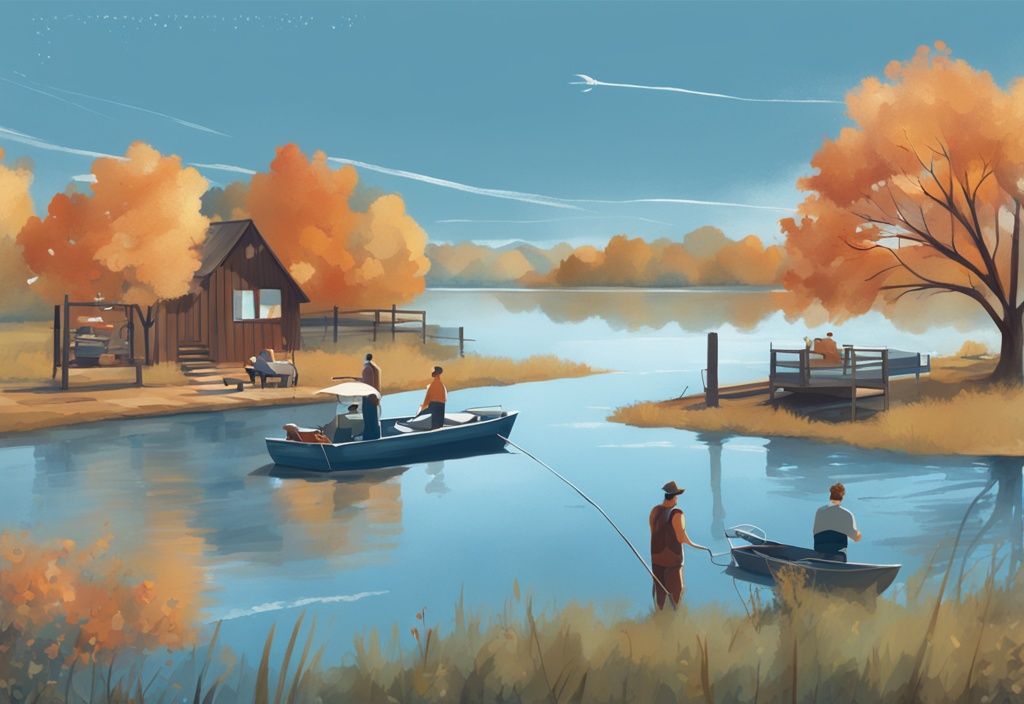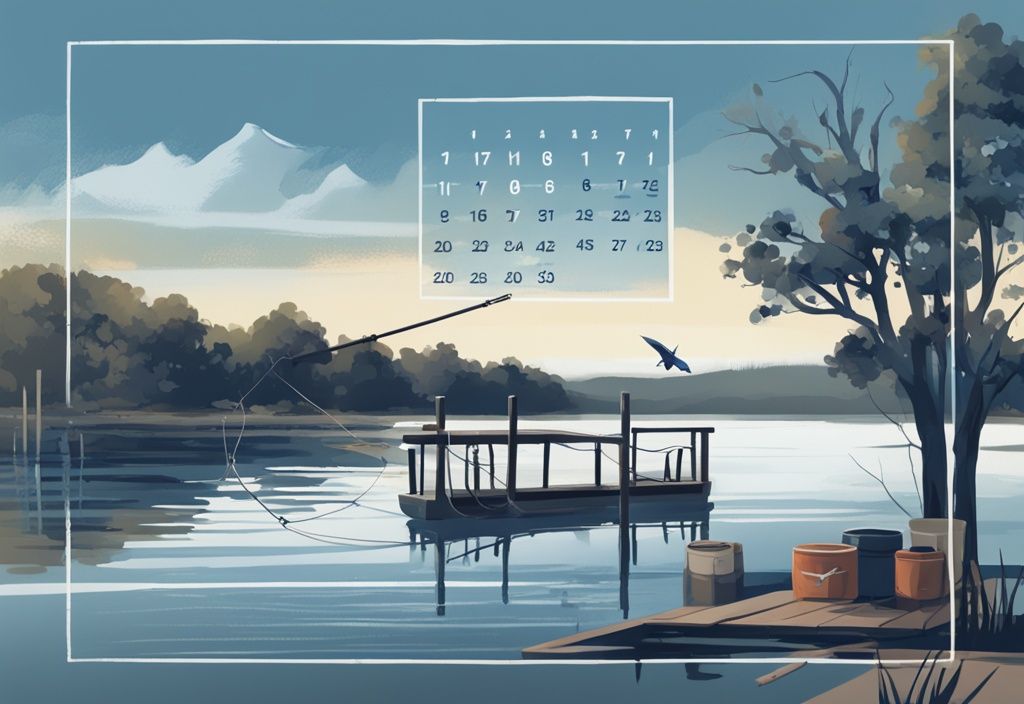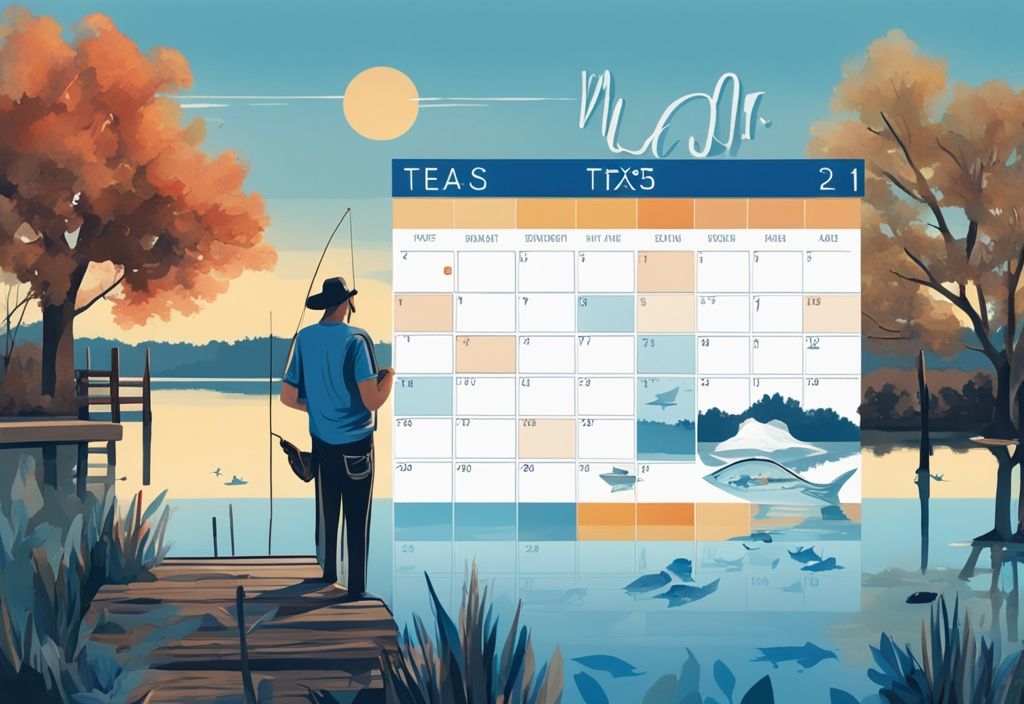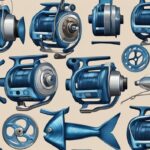Ever been stumped on when the fishing season in Texas really kicks into high gear? Not anymore, partner! Picture yourself, rod in hand, feeling that first exhilarating tug from that Texas-sized bass. We’re about to lay out an ideal roadmap for every angler looking to make the most out of the Texas fishing season.
Whether it’s the pull of freshwater or saltwater, Texas offers year-round opportunities. But if the question, “When is the ideal time to fish in Texas?” is nagging you, you’ve cast your line in the right lake. We’re going to detail when to target your favorite fish – be that bass, catfish, or red snapper.
Rest easy, knowing that we’ve got the prime fishing seasons, species-specific peak periods, and key regulations covered. No more second-guessing your trip timing, just clear skies, calm waters, and plenty of fish waiting to bite. Ready to reel in a big one, friend?
Overview of Fishing Seasons in Texas
Texas is truly a haven for fishing enthusiasts, offering year-round opportunities that promise excitement no matter the month. Whether you’re dipping your line in freshwater lakes or venturing into saltwater coasts, there’s always something ready to bite. While the fishing season in Texas never officially closes, knowing the best times to fish can turn a good day into a great one. The prime times change depending on your target species and personal preferences, but there’s a rhythm to Texas fishing that you can rely on.
Fishing season in Texas is wide open throughout the year, but timing your trips can make a huge difference in your haul. Freshwater anglers often see the most action from spring through fall. This period aligns with heightened fish activity, giving you a better shot at a productive outing. The warmer months, particularly from April to August, are golden. The weather and water temperatures during this time draw fish closer to the surface, making them easier to catch.
Texas Fishing: Year-Round Opportunities and Peak Seasons
Texas is famed for its year-round fishing, and rightly so. The state’s varied aquatic environments mean you can enjoy a successful fishing trip any time. The peak periods shift depending on the species you’re chasing. Bass and crappie, for instance, are more active in autumn and spring, thanks to favorable water conditions that spur their activity.
But don’t discount the summer months from April to August. The warmth of these months fosters ideal conditions that make fish particularly active. This is prime time for both seasoned anglers and newcomers alike, as the fish are more likely to bite, creating an invigorating experience.
Whether you’re taking to a tranquil freshwater lake or heading to the bustling saltwater coasts, understanding when is fishing season in Texas is key. Season patterns and fish behavior are your guiding stars to maximize your catch, making each trip more rewarding.
When is Fishing Season in Texas
Texas offers diverse freshwater fishing options, with different species reaching their peak activity at various times throughout the year. Understanding when to target specific fish can dramatically enhance your chances of a successful catch.
Maximum Catch: Optimal Times for Different Freshwater Species
Bass Fishing Season: Spawning Period (February to April)
Bass fishing is immensely popular in Texas, particularly during the spring spawning period. Picture yourself casting a line in the serene morning mist, waiting for the telltale strike of a largemouth bass. The peak season usually kicks off in February and gains momentum in March, continuing into April. Whether you’re after largemouth, spotted, or white bass, this period is your golden window.
Catfish Season: Breeding Time (May and June)
For those hooked on catfish, aim for the breeding months of May and June. Think of warm evenings by the water, the air filled with anticipation and the promise of a hefty channel, blue, or flathead catfish on your line.
It’s a time when these whiskered giants are most active and relatively easier to catch, making it an excellent opportunity for a significant haul.
Crappie Season: Active Period (Late February to Mid-April)
Crappie fishing comes alive from late winter through early spring. Imagine slowly drifting on a calm lake, the chill of late February in the air, as you reel in black and white crappies. This period, stretching to mid-April, offers anglers plenty of action and the thrill of crappie activity at its peak.

Trout Fishing Season: Prime Time (December through February)
Trout fishing in Texas shines during the colder months. Picture this: the brisk mornings of December, with a hint of frost, perfect for chasing rainbow and brown trout. This prime window extends through February, aligned with the stocking activities of the Texas Parks and Wildlife Department. It’s a season tailor-made for memorable outings, ensuring enthusiastic trout anglers enjoy fruitful catches.
Understanding when is fishing season in Texas and targeting species during their peak times will significantly enhance your fishing experience. Aligning your fishing trips with these optimal periods ensures a higher chance of success and enjoyment.
Guide to Saltwater Fishing Seasons in Texas
Onshore Fishing Opportunities: When to Catch the Most
Inshore saltwater fishing in Texas is a year-round adventure that presents prime opportunities to land a variety of fish species, depending on the season. Understanding when is fishing season in Texas can dramatically affect your catch rate.
Prime Time for Inshore Saltwater Fishing: Spring and Fall Peaks
Spring and fall are the golden seasons for inshore saltwater fishing in Texas, offering the most plentiful catches. During these times, the waters are brimming with Redfish and Spotted Seatrout, species that can be caught throughout the year but are particularly active in these seasons. Picture the crisp spring air and the warm fall sunsets; they create a perfect backdrop for fishing adventures that brim with excitement and fruitful outcomes.
Summer months bring their own charm to inshore fishing, with high activity levels for species like Redfish, Flounder, Black Drum, and Red Snapper. The warmer the water, the more lively the fish, making them easier to hook. Thanks to rising water temperatures and abundant food sources, summer fishing can be immensely rewarding.
Inshore anglers can make the most of these peak periods to enhance their fishing experiences. Planning trips during the optimal seasons and aiming for the right species can significantly boost your success rate. Knowing when is fishing season in Texas can transform your outings from mere attempts into triumphant endeavors, ensuring that every trip is a story worth telling.
So grab your gear, mark your calendar, and get ready for an exciting journey into the world of Texas inshore saltwater fishing. Whether you’re a seasoned pro or just starting out, every season has something unique to offer.
Navigating the Offshore Fishing Seasons in Texas
Offshore fishing in Texas offers a vibrant array of opportunities throughout the year. Each season brings its unique set of key species, making it essential to know the best times to hit the waters.
Prime Time for Offshore Fishing: Key Offshore Species and Their Seasons
Offshore fishing in Texas boasts a varied and exciting range of opportunities, especially during the warmer months. Knowing when to target specific species can significantly enhance your success rate and overall fishing experience.
April: Time for Mahi Mahi, Kingfish, Snapper, Grouper
April marks the commencement of the offshore fishing season in Texas, offering anglers the chance to catch some of the ocean’s most sought-after species. During this month, Mahi Mahi, Kingfish, Snapper, and Grouper are in abundance. The warming waters create optimal conditions, drawing these species closer to the Texas coastline. Anglers can expect vibrant and active fish that are ready for a challenge.
June: Start of Federal Red Snapper Season
June heralds the beginning of the Federal Red Snapper season, a highlight for many offshore fishing enthusiasts. This period aligns with warmer temperatures and calm seas, making it an ideal time for targeting Red Snapper. The season is strictly regulated to ensure sustainability, but while it lasts, it provides some of the most thrilling fishing opportunities Texas has to offer. The abundance of Red Snapper during this period makes each trip potentially rewarding and exciting.
August: Billfish Season and Texas Legends Billfish Tournament
August is synonymous with Billfish season in Texas. This period witnesses a peak in the activity of Billfish, including Marlin and Sailfish, making it a prime time for seasoned anglers seeking both sport and trophy-worthy catches. Concurrently, the Texas Legends Billfish Tournament, one of the most prestigious events in the fishing calendar, also takes place in August. This tournament not only attracts avid anglers from across the nation but also highlights the exceptional offshore fishing culture in Texas. The combination of competition and peak species activity makes August a standout month for offshore fishing adventures.
By aligning your fishing trips with these seasonal peaks, you can capitalize on the most favourable conditions and maximize your chances of a successful and enjoyable offshore fishing experience in Texas.
By following the tips from experienced anglers and keenly observing nature’s cues, you can transform your offshore fishing trips into unforgettable adventures. Knowing when to head out and what to expect will undoubtedly enhance your time on the Texas waters. So gear up, plan your trips according to these prime times, and may your lines always be tight!

Texas Fishing Regulations: What You Need to Know
Fishing License: How to Get One
To fish legally in Texas, anyone intending to catch fish, mussels, clams, crayfish, or other aquatic life in public waters must obtain a fishing license. Depending on whether you plan to fish in freshwater or saltwater, you will need the appropriate endorsement on your Texas fishing license.
These licenses are essential for maintaining sustainable fishing practices and ensuring that the state’s aquatic resources are well-managed. Think of it as your ticket to preserving Texas’ rich fishing heritage for future generations.
Species-Specific Regulations: What You Should Know
Certain fish species in Texas are classified as game fish and are subject to specific regulations. For these species, fishing is typically allowed only by pole and line. Take the alligator gar, for instance—a prominent game fish that can only be harvested during a designated season which runs from September 1 to 30.
Understanding and adhering to these regulations is crucial for the conservation of Texas’ diverse fish populations. So, when you’re wondering “when is fishing season in Texas” for specific species, consider these set regulations and mark your calendars accordingly.
Conservation Rules: Protecting Texas Fisheries
Adhering to fishing regulations and conservation guidelines set by the Texas Parks and Wildlife Department (TPWD) is essential for ensuring sustainable fishing practices. It’s unlawful to capture, harm, or disturb protected species, such as sea turtles and endangered fish. Additionally, there are rules regarding the use and waste of fish.
Anglers must not allow edible fish or bait fish taken from public waters to die without intending to use them. This guideline doesn’t just avoid unnecessary waste but also supports the health of Texas fisheries. Picture it like this—each fish you save today helps keep the ecosystem balanced for the many fishing seasons to come.
Special Area Regulations: Ensure Compliance
Various state parks and water bodies in Texas have specific fishing schedules and regulations aimed at maintaining healthy fish populations. It’s important to stay aware of any special rules that may apply, including those related to transporting and importing wildlife and aquatic resources into the state.
Staying informed through the Texas Parks and Wildlife Department website is the best way to keep up with the latest fishing seasons, regulations, and licensing requirements. Understanding these regulations can help you determine when is fishing season in Texas for different species and locations. It’s like having a map that guides you through the best times and places to cast your line.
Capitalizing on Tidal Movements for Successful Saltwater Fishing
Mastering tidal movements can dramatically boost your saltwater fishing game. Understanding tides can help you predict fish activity, making it easier to plan when and where to cast your line.
Understanding the Impact of Tides on Fishing
Tidal movements are a game-changer in saltwater fishing. Picture this: as the tides rise and fall, they create a dynamic environment teeming with baitfish, which in turn attract larger predator fish. By tuning into these natural rhythms, you can elevate your fishing success. The prime times are during incoming or outgoing tides. Ever noticed how the water movement is more pronounced during these periods? That’s when the magic happens. Nutrients are stirred up, baitfish swarm, and larger fish come in for a feast. On the flip side, slack tides—when the water is virtually still—often mean less fish activity. It’s like nature hits the pause button, and your chances of a catch dip significantly.
Using Tidal Conditions to Enhance Your Catch
Let’s talk strategy: incorporating tidal predictions and charts into your fishing plan can yield optimal results. Keeping an eye on these predictions helps you pinpoint periods of strong tidal movement. When planning your trips, aim for that sweet two-hour window after high and low tides. Why, you ask? Because these times often provide the best conditions for a productive fishing experience. During these windows, the water’s brimming with life, and fish are on the hunt. In my two decades on the water, understanding and leveraging these tidal patterns has proven to be a foolproof strategy.
Wrapping your head around tidal movements isn’t just smart; it’s essential for any saltwater angler. It’s like having an insider’s tip that transforms your fishing excursion from a guessing game to a calculated adventure. Remember, each trip offers new lessons, so keep those eyes on the tides and that rod ready!

Frequently Asked Questions
When is the best fishing season for bass in Texas?
The best fishing season for bass, especially largemouth and white bass, is during the spawning period between February and April. Picture this: bass are more active and easier to catch, making it the golden time for fishing enthusiasts looking to fill their coolers. The excitement in the air, the thrill of the catch—it’s unrivaled. If you’ve ever felt the adrenaline surge of battling a hefty bass, you’ll understand why this time is treasured.
Is a fishing license required to fish in Texas?
Yes, a fishing license is a must for anyone casting a line in Texas’s public waters. This isn’t just a bureaucratic hiccup—it’s a cornerstone of sustainable fishing that helps keep our fish populations vibrant. Think of it as your ticket to preserving nature’s splendor for future anglers, ensuring that fishing here remains a richly rewarding experience.
What are the ideal months for offshore fishing in Texas?
If you’re dreaming of offshore fishing adventures, pencil in June through August. These are prime months when the waters are teeming with Mahi Mahi, Kingfish, and Snapper. Can you imagine the blitz of action as you reel in one of these beauties? It’s a season where every cast has the potential to be a story worth retelling around a campfire.
Are there any periods where fishing is prohibited in Texas?
While you can enjoy fishing year-round in Texas, specific regulations apply to certain species. For instance, alligator gar can only be harvested in September. These regulations aren’t arbitrary—they’re carefully placed to help protect and maintain fish populations. So, whether you’re fishing or relaxing, you know you’re contributing to the health of these ecosystems.
What is the optimal season to fish for catfish in Texas?
May and June are prime months for catfish, thanks to their breeding season. If you’ve ever felt the solid tug of a catfish on your line, you know how exciting this time can be. The fish are more active, making these months ideal for landing a big one. It’s like the fish are just waiting for an invitation to dinner.
When is the Federal Red Snapper season in Texas?
Head offshore starting in June for the Federal Red Snapper season. This time marks the beginning of amazing opportunities to target Red Snapper—think vibrant red hues thrashing in the blue ocean. It’s the perfect excuse to gear up and hit the seas, knowing that this season is tailor-made for crafting unforgettable fishing memories.
Conclusion
Fishing in Texas is an angler’s paradise, offering year-round opportunities that cater to all skill levels. With its diverse ecosystems and rich variety of species, you can find your perfect fishing adventure regardless of the season. The state’s extensive freshwater lakes, rivers, and coastal waters promise endless excitement and bountiful catches any time of the year.
Understanding the peak times for different fish species is crucial for maximizing your fishing success. For example, bass fishing reaches its height during the spring months from February to April. Catfish are most readily caught during their breeding season in May and June. If trout is your target, the colder months from December to February provide the best opportunities. Prime times for inshore and offshore saltwater fishing also vary. Redfish and seatrout are most active in spring and fall, while offshore species like Mahi Mahi, Kingfish, and Snapper hit their peak starting in April. Adhering to local regulations is essential for sustainable fishing. If you’re planning to fish in different states, it’s important to know how to obtain a fishing license in Montana. This ensures that Texas waters remain plentiful for generations to come. Texas Parks and Wildlife Department (TPWD) regulations offer clear guidelines on fishing licenses, species-specific rules, and conservation practices. For instance, licenses are required for fishing in public waters, and specific species like the alligator gar have designated harvest seasons. Always check for the latest TPWD regulations to stay informed and compliant, as these rules are designed to protect the ecosystem and promote responsible fishing practices.
Planning your trip around the optimal fishing seasons, understanding key tidal movements, or simply following local regulations can significantly enhance your fishing experience. Stay updated with the latest from TPWD to ensure you are well-prepared.
Fishing in Texas is not just a pastime—it’s an adventure waiting to unfold, with each season presenting unique opportunities and challenges. By staying aware of the best fishing times and adhering to local guidelines, you’ll ensure a successful and enjoyable fishing trip in the Lone Star State.


